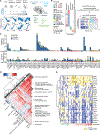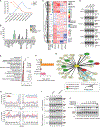Systematic exploration of dynamic splicing networks reveals conserved multistage regulators of neurogenesis
- PMID: 35914530
- PMCID: PMC10686216
- DOI: 10.1016/j.molcel.2022.06.036
Systematic exploration of dynamic splicing networks reveals conserved multistage regulators of neurogenesis
Abstract
Alternative splicing (AS) is a critical regulatory layer; yet, factors controlling functionally coordinated splicing programs during developmental transitions are poorly understood. Here, we employ a screening strategy to identify factors controlling dynamic splicing events important for mammalian neurogenesis. Among previously unknown regulators, Rbm38 acts widely to negatively control neural AS, in part through interactions mediated by the established repressor of splicing, Ptbp1. Puf60, a ubiquitous factor, is surprisingly found to promote neural splicing patterns. This activity requires a conserved, neural-differential exon that remodels Puf60 co-factor interactions. Ablation of this exon rewires distinct AS networks in embryonic stem cells and at different stages of mouse neurogenesis. Single-cell transcriptome analyses further reveal distinct roles for Rbm38 and Puf60 isoforms in establishing neuronal identity. Our results describe important roles for previously unknown regulators of neurogenesis and establish how an alternative exon in a widely expressed splicing factor orchestrates temporal control over cell differentiation.
Keywords: RNA-binding proteins; alternative splicing; gene regulation; high-throughput screening; neurogenesis; single-cell profiling.
Copyright © 2022. Published by Elsevier Inc.
Conflict of interest statement
Declaration of interests B.J.B. and A.-C.G. are members of the Molecular Cell advisory board. The remaining authors declare no competing interests.
Figures






References
Publication types
MeSH terms
Substances
Grants and funding
LinkOut - more resources
Full Text Sources
Molecular Biology Databases
Research Materials

